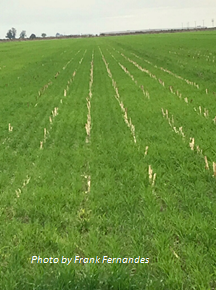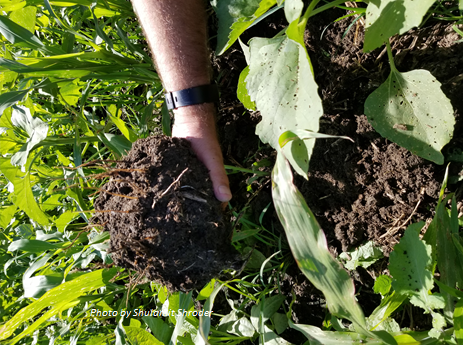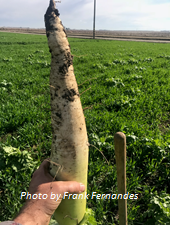When you think of armor, you might think of medieval knights protecting damsels in distress. For Frank Fernandes of Legacy Ranch, though, the damsel in distress is his soil. To protect his soil from compaction and weed pressure, he has experimented with strip tillage and cover crops in his forage crop fields. He calls these practices “soil armor.”
Reduced tillage
Soil armor means keeping the soil covered as much as possible. Instead of tilling the corn residues into the soil, Frank uses a no-till drill to seed the next crop. This leaves the previous crop's stubble on the field, protecting the soil from erosion. The corn residue acts like a mulch and keeps the soil surface cool, reducing evaporation even on hot days.
In the photo below, you can see the stalks of corn that remain, even after he planted a new crop in the field. This residue will slowly break down and feed the microbes in the soil. It will eventually provide nutrients to later crops. 
Cover crops
Frank also plants a diverse mix of cover crops between his corn and wheat rotation. This has reduced his weed pressure and enabled him to save money on herbicide applications and tractor passes.
One of the species he likes to plant is called a “tillage radish.” As you can see in the picture below, this plant develops a long, thick taproot that breaks up compaction. It decomposes quickly, leaving channels through which water can flow and roots can grow.
Benefits
Frank has experimented with these practices for a few years and has already noticed major improvements in these fields. His irrigation water percolates into the soil more quickly than it did in the past. He has increased the interval between irrigations, because the soil is able to hold onto more water. He has reduced the number of tractor passes. His fertilizer and herbicide needs have decreased. All these benefits have saved him tens of thousands of dollars.
What about yield? As might be expected for a new system, he has seen some drop in yields. However, this reduction has not been substantial and some fields have even reported increased yields. For Frank, the reduction in costs more than outweighs the slight reduction in yields. Yields should improve as the soil becomes healthier. 
Climate smart agriculture encompasses management practices that increase soil carbon sequestration, reduce greenhouse gas emissions, improve yields and efficiencies, and promotes climate resilience. The California Department of Food and Agriculture (CDFA) supports three funding opportunities in climate smart agriculture: the Healthy Soils Program, the State Water Efficiency & Enhancement Program, and the Alternative Manure Management Program.
In a collaborative partnership, CDFA and UC Agriculture and Natural Resources have teamed up to support 9 community education specialists throughout the state to provide technical assistance and outreach for the climate smart agriculture programs. To learn more and locate a specialist near you, visit http://ciwr.ucanr.edu/Programs/ClimateSmartAg/.
